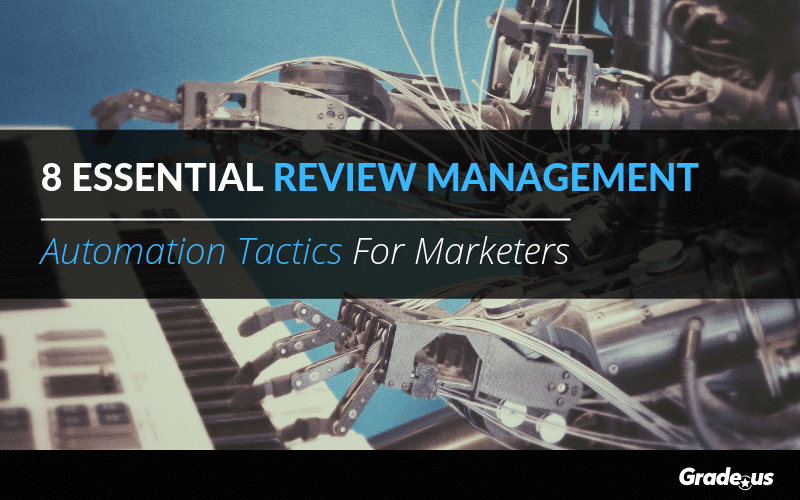Updated 4/29/2022
Review management can be done manually.
It’s painstaking and tedious if you decide to go this route. Smart and resourceful marketers know better; they implement automations to save time.
You know the axiom.
It’s all about working smarter, not harder. So why not use various review management automation tactics? Is it a matter of not knowing what you can automate or how to automate it?
Think about it this way. It’s a catch-22.
You have received rave reviews from your customers, reviews you weren’t aware of. They post on some obscure third–party review site, you didn’t see their review, and you inadvertently ignored them.
It left a bad taste in their mouth.
If you’re dealing with a negative review from an unhappy customer, the situation is even worse. Now, instead of working with you to resolve their situation, they’re sharing their negative feedback on multiple review platforms in an effort to get your attention.
It’s an unhappy situation all around.
Why review management automation is a necessity
Review management requires a significant amount of ongoing attention. If you’re a small business managing your own review portfolio, at some point you’re going to need help.
There are more than 300+ review platforms!
They’re an eclectic mix of mainstream, social, niche, and specialty review platforms. Which one of these is most significant to your customer? Where do they feel comfortable?
Have you claimed profiles on each of the relevant platforms for your industry? Are you monitoring reviews that come in on your profile page(s)?
It’s too much to handle manually.
Here’s the other problem. Positive reviews, if you’d like them to produce revenue, require a large amount of initial attention to be effective. Want to figure out how to feature reviews on your website, blog, ad or retargeting campaign?
Need to know which reviews to respond to and when?
Manual labor.
Automating the review request and follow-up process over the course of several days or weeks?
Ma— okay you get it.
See what I mean though? It’s super difficult, very much an inconvenience. It’s easy to let things lapse because you forgot to check a particular profile, or because someone on your team dropped the ball. That’s a problem, because you have a business to run. If you’re like most businesses, you don’t have time to hover over your review profiles.
Only you should.
Remember that research from Northwestern I mentioned in my previous posts? Their Spiegel Research Center found online reviews could increase conversion rates by 270 percent!
That’s not a typo.
You read that right. Now compare and contrast that with data from Moz. Their research stated that businesses risk losing as many as…
- 21.9 percent of customers if you have just 1 negative review listed on page one of Google
- 44.1 percent of customers if you have 2 negative results
- 59.2 percent of customers with 3 negative results
- 69.9 percent of customers with 4 negative results
Yikes.
Yeah. The data clearly shows the importance of online reviews, and also hovering over reviews. That’s a bitter pill to swallow, because most business owners (and agencies) don’t have that kind of time.
What if you did?
What if you could get someone to stalk your review profiles for you? To hover over them on a regular basis?
Using review management automation to surpass larger competitors
Review management automation is a helpful value-add, a must if you’re looking to minimize busywork while maximizing revenue and results.
What are some ways you can implement review management automation?
Review funnels
When customers are added to your review funnel they receive a consistent stream of messages via the platform of your/their choice. This is important because 70 percent of customers will leave a review when asked. If you’ve done a great job, asking for a review is a slam dunk. It’s an easy way to boost your conversion rate, score more sales and increase your revenue.
Your review funnels should be omnipresent.
Your in-store signage, marketing collateral, landing pages, ads, social media, and offer pages should all link to your reviews and your review funnel. It should be easy for customers to write a review about your business.
That’s the problem, though, isn’t it?
Many business owners are afraid of what customers will say. Most would prefer to curate a special list of customers who already have a favorable opinion of their product or service.
This is a bad idea.
Bad reviews are an important, necessary, and healthy part of your review portfolio. Nothing sets off warning bells in a customer’s mind like the review profile that’s loaded with five-star reviews and zero one-star reviews.
It seems too good to be true.
Negative reviews are a must-have for your business.
How do I know?
Businesses whose total number of reviews are 15-20% negative average 13% more annual revenue than businesses whose reviews are 5-10% negative.
That’s right.
If 15-20% of your reviews are negative, the research shows you earn more revenue than companies with less. There’s no need to fear your negative reviews.
If a negative review comes in, get more positive reviews!
Clean up the legitimate issues brought up in your customer’s complaint, work to win your reviewers back, then request a positive review after you’ve done so.
Review profile management
Have you claimed all of your review profiles? Are you absolutely sure? You should be able to monitor citations, name address phone (NAP) details, and general profile data. No need to waste time trying to figure out which review profiles you need to manage/follow.
Using your review management automation, you should be able to monitor incoming reviews automatically.
Review monitoring
When customer reviews come in, do you find out right away? You should. Review monitoring allows you to get ahead of any bad press, identify positive PR sources and cultivate positive goodwill with customers. A good review monitoring solution provides immediate updates, notifying you when a review (positive or negative) comes in.
If you’re doing reputation management right, you have multiple review profiles.
- Mainstream sites like Google, Facebook, and Yelp
- Niche sites like TripAdvisor or the BBB
- Industry-specific sites like Healthgrades, Zillow, or Wedding Wire
These are all difficult to monitor manually.
Your reputation management campaigns should be semi-automated. You should receive immediate notifications when a customer writes a review or engages with your business on a review site. You’ll want to set up notifications in your reputation management tool of choice. Doing so means you can get ahead of anything that comes, whether that’s positive or negative.
Custom feedback workflows
You can create your own workflows, approaching customers the way you want to, when you want to. Combine these workflows with a special offer to thank customers for their business (just avoid bribes and kickbacks), invite them to join another autoresponder sequence, or create another irresistible offer. It’s all up to you.
What does this workflow look like?
Here’s a simple feedback request workflow for an ecommerce store.
- A. Customer purchase completed
- B. Order shipped
- C. First review request via email and text once the product is delivered
- D. Second review request sent via email and text, 3 days post-delivery
- E. Final review request sent via email and text, 6 days post-delivery
What about a service business?
- A. Customer signs service agreement
- B. Phase one complete: Informal "how are we doing?" request sent
- C. Phase two complete: Client update sent.
- D. Final phase complete: Post-project evaluation and first review request via email and text
- E. Second review request sent via email and text, 3 days after project completion
- F. Final review request sent via email and text, 6 days after project completion
Using a review management tool like Grade.us, you can customize, send, and manage your review requests at scale. That’s the beauty of all of this; you can tie this into your existing workflows. This ensures that every customer or client receives a review request from your organization.
Email invites
This is another valuable part of a strong review portfolio. Creating an autoresponder sequence ahead of time gives you the chance to send consistent follow-up/requests to customers, letting them know that, for better or worse, you’re interested in their feedback. What if your customers aren’t all that interested in using email?
Not to worry, customers still love email.
According to Adobe’s 2017 and 2019 Consumer Email Survey, customers are still obsessed with email. Not only that, customers in the survey state that they still want to hear from brands.
No kidding.
A good rule of thumb would be to send your customers one to three review requests oriented around a specific theme.
- How did we do?
- Did we make you happy?
- What can we improve for you?
You can send two versions of these review requests via email and SMS (which I’ll get to in a moment).
Phone/SMS invites
SMS invites enable you to follow up with customers directly, reaching out to them in a way that’s short to generate an immediate response. Phone/text, when paired with email invites, produces a higher response rate, greater levels of customer goodwill, and improved campaign performance. It’s a straightforward and (direct ) way to attract the kind of attention you need from your customers.
But it’s creepy, isn’t it?
Getting customers to opt-in to SMS marketing is one thing, but requesting reviews from customers with an actual conversation?
This feels like maximum cringe.
Only it’s not.
Research from Salesforce shows something surprising.
“Access to content “any way I want” is consumers’ most important criteria when rating mobile brand experiences. In fact, 91% of consumers say access to content any way they want is important to them. Eighty-three percent of consumers also say a seamless experience across all their devices is important to them— and this number increases when considering just those who own both a smartphone or a tablet (87% of consumers who rated this factor as important owned both devices).”
See that?
According to this research, customers actually want to hear from you. They want the option to be able to access content the way they want —this includes online reviews.
Customers expect it.
They want to be able to share their feedback on their terms, where and when they want to, and they expect you to facilitate this.
Review requests via SMS enable you to do this at scale.
Review marketing
Most of the time, customer reviews wither on the vine. Customers share a review on Google, Yelp, or Facebook. Their review is incredible, it attracts a significant amount of attention – at first. It certainly helps you build a stronger review profile, but it doesn’t do much more.
What if each customer review continued to earn for you?
With the right curation tools, you can place your reviews directly in front of new customers. You can embed reviews on your website and other sites, extending the life and value of your reviews.
Wait a minute.
Why would you place a customer’s reviews in front of prospects?
Well, that’s easy to answer.
Your online reviews can be used at any stage of your marketing funnel. It’s a light bulb moment for many marketers because it hasn’t occurred to them that their reviews should be bringing in revenue.
A. Use reviews to attract buyers.
- Share reviews via a remarketing campaign as a way to attract interested buyers
- Promote reviews via direct response channels like Bing, Google Ads, and Facebook Ads
- Use reviews to attract new subscribers via email or social media
B. Use reviews to convert buyers
- Convert customers via direct response, search, social, and remarketing campaigns
- Use reviews to win new customers via joint venture partnerships and affiliate campaigns
- Sell new email, SMS, and social media subscribers on a product, service, or system using buyer beliefs
C. Use reviews to increase product or service consumption
- Show buyers the results, outcomes, and rewards customers have achieved with your product or service
- Sell existing customers on new features or services via success stories from other happy customers
- Pre-sell new products and services to gain traction before you’ve launched or released your next offering
Reporting
What’s the overall feeling customers have about your business? Which objections, complaints, concerns, fears, frustrations, and expectations come up most often? You’d typically have to slog through the reviews on each of your profiles, taking note of any trends or important data.
But you’d undoubtedly miss something.
Sentiment analysis provides you with the (ongoing) measuring stick you need to assess your customer’s feedback. You’re able to figure out what works and why. If you decide to follow up with customers, yours or your competitors, you have detailed specifics outlining what you should ask about.
Wait a minute.
This automation thing sounds like a spammy way to approach review management.
It absolutely is.
If it’s placed in the wrong hands, manual review management is a disaster. If you’re a spammer, the channel isn’t an important detail.
It’s the access.
It’s the fact that a spammer has unfettered access to customer data – that’s the problem. But you’re not a spammer, are you?
No, you’re not.
If you’ve read this far, I assume you’re either (a.) a small or medium sized business trying to move performance up and to the right or (b.) you’re an agency managing this very involved process for a client who wants their performance to move up and to the right or (c.) both.
Review management automation allows you to scale your business
As we’ve seen, reviews play a dramatic role in your business. Your conversion rates, revenues and profit overall, they all depend on your reviews.
There are more than 300+ review platforms.
It’s too much to handle manually. Want your online reviews to produce revenue? That requires a large amount of initial attention to be effective. Or you can take the easy and more efficient path of automation.
This is how you avoid the catch 22.
Whether you’re dealing with a negative review from an unhappy customer or a positive review from a happy customer, your situation requires attention. Customers want to see that you’re open, honest, transparent and engaged. They want you to participate in the review management process.
Eventually, it becomes a deluge of information.
Review management automation cures this malady. With the right tools and the right mix of automation, you’ll find your business has everything it needs to generate traffic, leads and sales for your business, no bad taste necessary.









